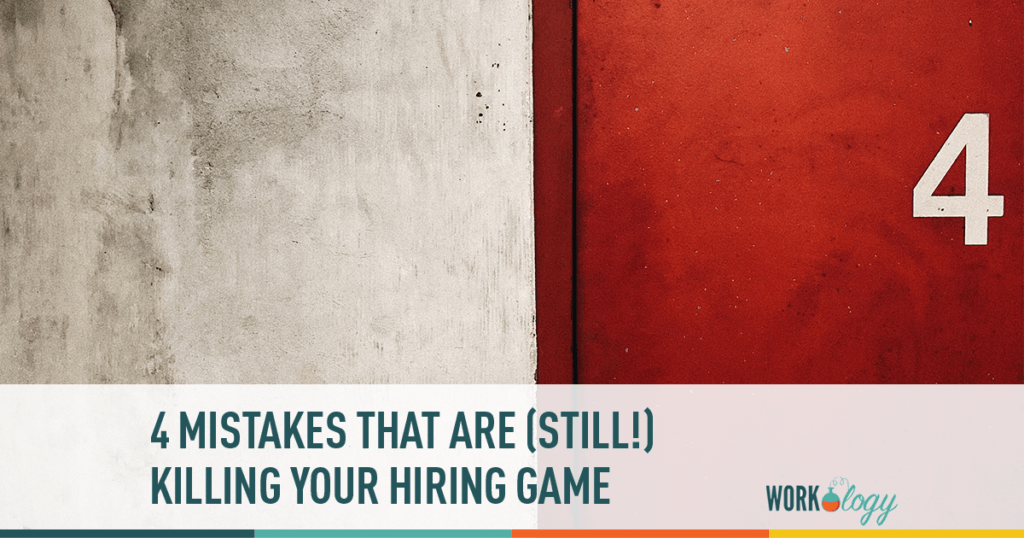Some organizations dictate best practices in the areas of employment and recruiting through their influence and reputation. Other organizations don’t have this advantage and often find themselves competing for top talent by working to adopt best practices as dictated by an ever-shifting market.
If you identify yourself, or your organization as the latter, what do you do about it?
Embrace reality; if being the type of organization that dictates recruitment best practices was a priority, you would already know about it. The task then is to position your organization so that it has a fighting chance in the market for top talent.
First and foremost, neutralize the practices that are working against you. In most cases this doesn’t mean completely changing the way you hire. It means making changes that are impactful but don’t require a fundamental shift in the way your organization does business.
Mistakes that Are (STILL!) Killing Your Hiring Game
The four practices below hurt your ability to accurately assess applicants, and give prospective candidates the wrong impression of you and your organization:
Completely Ignoring Social Media
Not every organization is ready to embrace social media. The case for or against it could fill a hundred other articles (after all, its 2016), but the reality is that today’s top candidates expect to be defined by more than just their resume. If you don’t include social media at some point in your process, you’re not getting the whole story on your candidates, and your candidates might consider the fact you haven’t brought some aspect of social media into the process a red flag.
How to Fix It:
You don’t have to go all in on social media; you just have to show that you aren’t willfully ignorant of it. Perhaps you don’t have the technical capability to have candidates apply using only their LinkedIn profile, but there is nothing that says you can’t ask for a link to their profile so you can review it. The same goes for other PUBLIC social media channels, including blogs and websites where candidates share their work. You just have to ask.
Additionally, you can run a few technical skill tests, besides the social media screening, based on the software frameworks required. You might consider MySQL test, Excel test, or any other which is designed to put a candidate’s words into action. That way, hiring managers can make educated decisions before extending a job offer.
Not Getting to the Point
Have you heard or seen the term “TLDR”? It means “too long, didn’t read,” and is most often employed when emails extend far beyond what our modern attention spans can handle. The same applies to your job postings. If a strong candidate can’t quickly determine whether they meet the minimum qualifications for a position or critically assess whether they can perform the job in question, they will move on.
How to Fix It:
You don’t necessarily have to change your entire posting process; you just have to make it easier for candidates to find the most important information. One solution, for example, might be to add a “Position at a Glance” section so viewers can quickly determine whether the position is right for them. If so, they can then move on to the remainder of the posting where the details carry much more weight for them.
Job Postings Only HR Can Understand
One of the fastest ways to lose a person’s attention is to force them to read through a series of HR buzzwords or internal speak that leaves even the most interested candidate begging for a reprieve. A job posting is not the same as a job description, and the crossover of much of the same content only hurts everyone involved. Candidates can’t understand exactly what is required of them, and you end up with applicants who only had a vague understanding of the position before they skipped to the “APPLY” button at the bottom of the screen.
How to Fix It:
A posting is a marketing tool, not a job description. There are all kinds of cool resources out there that speak to this, but you already have access to some that are incredibly relevant to your organization; the people you just hired. Ask them about how they approached the posting. What were they looking for first? How long did they spend viewing the posting? What worked for them? What didn’t?
Not Providing Salary Information
When candidates look for work, they attempt to answer two questions in rapid succession. 1) Can I see myself working for this organization?, and 2) Will I be able to advance or maintain my lifestyle if I end up taking this role? The latter in most organizations is the source of many assumptions on the candidate’s behalf because salary information is often unavailable or difficult to find. This requires candidates to apply without essential information, meaning they might be disappointed down the line if the salary doesn’t meet their expectations.
How to Fix It:
This should be easy, but it most likely won’t be. Post the salary or the salary range for each position in terms everyone can understand. Is the salary range negotiable? Say so. Does placement within the salary range depend on experience and education? Explain how. Do other benefits offset the starting salary? Show how. Is the opposite true for all of the above? Say so. The last thing you want is a candidate who gets an offer they can easily refuse.
What practices did we leave out? Are there hiring processes that once served a vital purpose that no longer have relevance in your organization? If you are a job seeker, what aspects of the hiring process “grind your gears”? We’d love to hear your thoughts in the comments.









